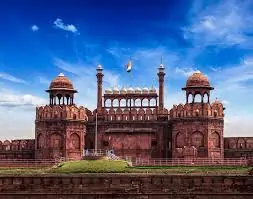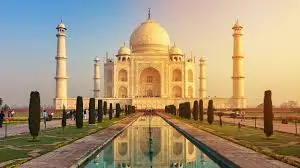The Red Fort (Lal Qila) is a UNESCO World Heritage Site in Delhi, India, renowned for its majestic red sandstone walls and its historical significance as the Mughal emperors’ residence and a symbol of Indian independence.
ADVERTIDEMENT

Table of Contents

The Red Fort (Delhi)
The Red Fort, also known as Lal Qila, is an enduring symbol of India’s rich history, cultural heritage, and architectural brilliance. Located in the heart of Old Delhi, this iconic fortress was commissioned by the Mughal Emperor Shah Jahan in 1638 when he decided to shift the Mughal capital from Agra to Delhi. Constructed over a span of 10 years, the fort is an exemplary blend of Persian, Timurid, and Mughal architectural styles, making it one of the finest monuments of the Mughal era.
The Red Fort served as the main residence of the Mughal emperors for almost two centuries, until the British took control in 1857. During its prime, it was not just a royal residence but also a political and cultural hub of the Mughal Empire. The fort housed opulent palaces, administrative offices, and lush gardens, reflecting the grandeur and sophistication of Mughal rule.
After the decline of the Mughals, the British used the fort for administrative purposes. Following India’s independence in 1947, the Red Fort became a symbol of freedom, and every year, on August 15th, the Prime Minister hoists the national flag here to mark India’s Independence Day.
The Red Fort (Delhi): A Comprehensive Overview
I. Introduction
The Red Fort, or Lal Qila, stands as a monument of historical, architectural, and cultural significance in the heart of Delhi, India. Built by the Mughal Emperor Shah Jahan in 1638, this imposing fortress was intended to serve as the palace and administrative hub of his new capital, Shahjahanabad (modern-day Old Delhi). The fort’s distinctive red sandstone walls and its strategic location along the Yamuna River make it a visual and symbolic marvel.
Over centuries, it has witnessed the glory of the Mughal Empire, the decline brought by colonial conquest, and the rise of modern India. Today, it is a UNESCO World Heritage Site and a symbol of national pride, especially celebrated during India’s Independence Day festivities when the Prime Minister hoists the national flag from its ramparts. Its blend of Mughal architecture, historical importance, and cultural resonance makes it one of India’s most treasured landmarks.
II. Historical Background
Construction and Purpose
The construction of the Red Fort marked a turning point in the Mughal dynasty’s history. Shah Jahan, renowned for commissioning the Taj Mahal, sought to shift the Mughal capital from Agra to Delhi to consolidate his rule and establish a center that reflected his empire’s grandeur. The fort was designed to serve multiple purposes: as a royal residence, a seat of government, and a showcase of Mughal power and artistry. Built over a decade (1638–1648), the Red Fort featured sprawling gardens, luxurious palaces, and intricate water systems that embodied the Mughal aesthetic of paradise on Earth.
Colonial Period
The fort’s history took a dramatic turn in 1857 during the Indian Rebellion against British rule. After the mutiny was suppressed, the British exiled the last Mughal emperor, Bahadur Shah Zafar, and took control of the fort, stripping it of its treasures and transforming it into a military base. Many original structures within the fort were demolished to make way for British barracks, and its role as a center of power faded.
Post-Independence
In 1947, the Red Fort regained its prominence as a symbol of freedom when India achieved independence from British rule. On August 15 of that year, the first Prime Minister, Jawaharlal Nehru, hoisted the Indian tricolor flag from the fort’s Lahori Gate, a tradition that continues annually. Today, the fort is celebrated not just for its Mughal legacy but also as a living symbol of India’s hard-won independence.
III. Architectural Features
Materials and Style
The Red Fort’s architecture is a masterpiece of Mughal engineering, blending Persian, Timurid, and Indian influences. Built primarily from red sandstone, its design features intricate marble inlays, symmetrical layouts, and ornate carvings. The fortress was intended to represent the pinnacle of Mughal sophistication and the emperor’s vision of a utopian city.
Layout and Dimensions
The fort spans 254 acres and is enclosed by massive walls that stretch 2.5 kilometers. These walls, varying between 18 and 33 meters in height, were designed for both defense and grandeur. Inside, the fort is divided into public and private spaces, connected by lush gardens, fountains, and canals.
Key Structures:
- Lahori Gate:
The primary entrance and an enduring symbol of India’s independence. The gate’s imposing design and historical significance make it one of the most recognizable features of the fort. - Delhi Gate:
A secondary entrance used for ceremonial purposes during the Mughal era. - Diwan-i-Aam (Hall of Public Audience):
This grand hall was where the emperor addressed the general public and resolved grievances. Its open design and raised throne symbolize the Mughal tradition of justice and governance. - Diwan-i-Khas (Hall of Private Audience):
A lavishly decorated hall reserved for private meetings with high-ranking officials and foreign dignitaries. Its marble pillars and the famous inscription—“If there is a paradise on Earth, it is this”—exemplify Mughal artistry. - Rang Mahal (Palace of Colors):
This residential palace for royal women was known for its vibrant interior and central water channels, which kept the space cool and added to its aesthetic charm. - Moti Masjid (Pearl Mosque):
Built by Aurangzeb, this small mosque is constructed of white marble and reflects the simplicity and elegance of Islamic design. - Naubat Khana (Drum House):
Situated near the entrance, this structure housed musicians who played ceremonial music to announce the arrival of the emperor and dignitaries. - Gardens and Water Features:
The fort’s layout incorporates charbagh gardens, a hallmark of Persian landscape design, with pathways and fountains symbolizing paradise.
IV. Cultural and Historical Significance
Role in Mughal Empire
The Red Fort was the epicenter of Mughal politics, culture, and art. It hosted grand celebrations, royal audiences, and cultural events that showcased the empire’s sophistication. Its design, with luxurious palaces and lush gardens, exemplified the Mughal ideal of a harmonious blend of nature and architecture.
Symbol of Freedom
During the British era, the fort became a symbol of resistance and revolution. Post-independence, its association with freedom was cemented through the annual Independence Day flag-hoisting ceremony, where the Prime Minister delivers a speech to the nation, reinforcing its status as a national emblem.
V. Tourism and Attractions
Visitor Experience
Tourists from around the world visit the Red Fort to explore its majestic architecture, rich history, and cultural significance. Walking through its courtyards, palaces, and museums offers a glimpse into the opulence of Mughal life and the fort’s historical role in India’s struggle for independence.
Sound and Light Show
A highlight for many visitors is the evening Sound and Light Show, which uses dramatic lighting and narration to recount the history of the fort and the Mughal dynasty.
Museums:
- Mughal Museum: Displays artifacts like royal clothing, weapons, and manuscripts from the Mughal era.
- Freedom Struggle Museum: Chronicles India’s independence movement through photographs, documents, and exhibits.
VI. Challenges and Preservation
Challenges
The Red Fort faces significant challenges, including environmental damage from pollution, overcrowding due to tourism, and natural aging of its structures. Additionally, the commercialization of surrounding areas has disrupted its original landscape.
Preservation Efforts
The Archaeological Survey of India (ASI) undertakes regular restoration work to preserve the fort’s integrity. Initiatives include eco-friendly practices, waste management systems, and controlled visitor access to minimize damage. Awareness campaigns aim to educate visitors about the importance of safeguarding this cultural treasure.
VII. Legacy and Global Recognition
Symbol of India’s Heritage
The Red Fort represents the peak of Mughal architectural ingenuity and the resilience of India’s cultural identity. It is a living monument that continues to inspire pride and unity among Indians.
UNESCO World Heritage Site
Recognized by UNESCO in 2007, the Red Fort is celebrated as a masterpiece of human creativity and a cultural landmark of global importance.
Cultural Hub
Beyond its historical significance, the fort remains a vibrant cultural space, hosting exhibitions, festivals, and national events that keep its legacy alive.
VIII. Conclusion
The Red Fort is not merely a monument but a bridge between India’s glorious past and its dynamic present. Its majestic architecture, profound history, and enduring cultural significance make it a must-visit destination. As a symbol of freedom and resilience, it continues to inspire millions. Ensuring its preservation is crucial, not just for India but for the world, as it stands as a testament to human creativity and the enduring power of cultural heritage.

